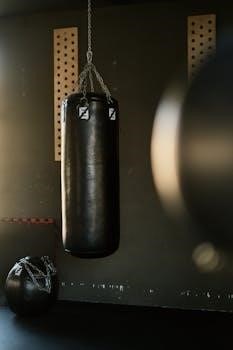boxing combinations pdf
Boxing Combinations PDF⁚ An Overview
This section provides an overview of boxing combinations, offering a structured approach to learning effective techniques. It will explore the basics and advanced combinations, enhancing training through PDF guides. These resources are vital for progressing skills.
Boxing combinations are sequences of punches thrown in a strategic manner, designed to overwhelm an opponent’s defense. These combinations move beyond single strikes, creating a fluid and powerful attack. Understanding them is crucial for both beginners and experienced boxers. Mastering the fundamentals allows for the building of more intricate attacks. Beginning with simple combinations, such as the 1-2, provides a foundation for complex sequences. The goal is to increase the boxer’s offensive capabilities, enabling them to land more frequently and effectively, and to control the rhythm of the bout. This introduction emphasizes the need to learn combinations to improve performance in the ring. Boxing combinations require practice and a lot of repetitions.
Importance of PDF Resources for Boxing Training
PDF resources are invaluable for boxing training, offering a portable and accessible way to learn combinations. These guides often contain diagrams, step-by-step instructions, and detailed explanations. This makes it easier to understand the nuances of each combination. PDFs can be accessed anytime, anywhere, facilitating consistent practice. They provide a structured approach to training, helping boxers progress systematically from basic to advanced combinations. This format allows for quick reference during training sessions. Moreover, PDF resources can complement a trainer’s instruction by offering additional visual and textual support. The ability to print and use these guides in the gym makes them a convenient tool, enhancing the overall training experience. They are essential for any boxer seeking to improve their skills.

Basic Boxing Combinations
This section introduces fundamental boxing combinations. These basic sequences are essential for beginners. Mastery of these combinations is important for building a solid foundation for more advanced techniques.
Jab and Cross Combination
The jab and cross combination, often called the 1-2, is the cornerstone of boxing. The jab, a quick, straight punch with the lead hand, sets the stage by establishing distance and disrupting the opponent’s guard. Following immediately, the cross, a powerful straight punch with the rear hand, delivers force and damage. This combination is a fundamental skill that every boxer needs to master. It’s simple to learn but requires constant practice for speed and accuracy. Proper footwork and weight transfer from back to front are crucial for maximizing the power of the cross punch. It is the primary attacking combination and also can be used defensively to set up more complex punches. The 1-2 is the most commonly used combination in boxing and it appears in many drills. Its simplicity makes it ideal for both beginners and seasoned professionals. The effectiveness of this combo can be seen in many fights.
The 1-2 Combination
The 1-2 combination, synonymous with the jab and cross, is a foundational sequence in boxing. It’s the first combination that most fighters learn due to its simplicity and effectiveness. The number ‘1’ represents the jab, a quick, linear punch thrown with the lead hand, meant to gauge distance and disrupt the opponent’s rhythm. The number ‘2’ denotes the cross, a more forceful punch delivered with the rear hand, designed to generate power. This sequence is not just about throwing two punches; it’s about timing, weight transfer, and proper footwork to enhance its impact. Mastering the 1-2 combination involves learning how to transition smoothly between the jab and cross, ensuring they flow together seamlessly. The execution of the 1-2 is not only an attacking strategy but also a defensive maneuver. Practicing this combination is essential for building a solid foundation in boxing. The 1-2 is the basis for many other more complex combinations.
Hook and Uppercut Combinations
Hook and uppercut combinations are essential for close-range combat, enabling fighters to strike at various angles. These punches are powerful and can cause significant damage. A hook is a curved punch delivered with either hand, targeting the sides of the opponent’s head or body. It requires a rotation of the hips and shoulders, generating power through the body’s core. An uppercut, on the other hand, is an upward punch aimed at the opponent’s chin or solar plexus. It also utilizes the power of the core and legs and is often used to break through an opponent’s guard. Combining hooks and uppercuts effectively involves strategic timing and placement. These combinations are not just about power; they also require precision and accuracy. Fighters learn to mix hooks and uppercuts to create openings and exploit vulnerabilities. Mastering these combinations is a critical step in becoming a well-rounded boxer, capable of fighting effectively at all ranges.

Advanced Boxing Combinations
This section delves into more complex boxing sequences, focusing on integrating footwork and intricate punch patterns. It explores advanced strategies that enhance a fighter’s agility and power, building upon core skills.
Incorporating Footwork into Combinations
Effective boxing combinations are not just about punches; they are deeply intertwined with footwork. Integrating movement enhances both offensive and defensive capabilities. Proper footwork allows fighters to create angles, generate power, and evade incoming attacks. For example, stepping in with a jab or pivoting after a cross can open up opportunities for follow-up punches, making combinations more fluid and effective. Footwork also enables the fighter to maintain balance and control, which is crucial in a dynamic fight situation. Moving in and out, shifting weight, and changing directions are all key components that make a combination work. This section will cover drills and techniques to integrate footwork seamlessly into boxing combination sequences. Using PDF guides, practitioners can visualize and practice these movements, refining their skills in a safe and structured manner. This integration of footwork with punch sequences transforms the fighter into a more unpredictable and effective combatant.
Complex Combination Sequences
Advancing beyond basic combinations, complex sequences require a deeper understanding of rhythm, timing, and strategy. These sequences involve multiple punches from different angles and levels, often incorporating slips, weaves, and pivots. A complex combination might start with a jab, follow with a cross, then transition into a hook, and finish with an uppercut, all while maintaining fluid motion and balance. Mastering these sequences demands rigorous practice and a strong foundation in fundamental techniques. Fighters need to develop the ability to chain punches together smoothly, without telegraphing their intentions. The goal is to overwhelm the opponent with a flurry of attacks that are difficult to predict and defend against. Complex combinations are not just about throwing more punches; they are about creating openings and exploiting weaknesses. This section will present examples of complex sequences through PDF guides, helping practitioners to visualize, learn, and execute these advanced movements. The study and practice of complex sequences are essential to elevate a fighter’s repertoire and competitive edge.

Training Resources and Drills
This section will explore practical training methods, including virtual padwork and sparring drills, that enhance the learning of boxing combinations. The focus is on practical application and skill development using various drills.
Virtual Padwork and Combination Drills
Virtual padwork offers a dynamic way to practice boxing combinations, allowing fighters to hone their skills without a physical partner. These drills often incorporate various sequences, such as the 1-2, hook and uppercut combinations, improving speed and accuracy. The use of virtual tools enables boxers to perfect their technique by following visual cues and timing prompts. Many online resources provide guided padwork sessions, where the user can simulate a real-time training environment. These virtual sessions help to develop muscle memory, which is essential for executing combinations effectively in sparring and matches. They also allow for consistent training at home, without the need for a trainer. Furthermore, these drills can be tailored to different skill levels, from beginner combinations to more advanced sequences. These sessions often include structured rounds with rest periods, mirroring the format of a boxing workout. This method is suitable for all who wish to engage in padwork without needing a training partner. The accessibility and flexibility of virtual padwork make it an invaluable tool for any boxer.
Sparring Combinations for Practice
Sparring provides an essential opportunity to apply learned boxing combinations in a dynamic, real-time scenario. It’s crucial to practice these combinations against a moving target to develop the timing and accuracy needed in a fight. Sparring sessions allow boxers to test the effectiveness of different sequences, such as the jab-cross-hook, and to adapt their approach based on the opponent’s reactions. Focusing on fluidity and precision is important, ensuring that combinations flow naturally and efficiently. Incorporating footwork into sparring drills is necessary for creating angles and openings. Boxers should experiment with a variety of combinations, from simple jabs to more complex series, while maintaining a strong defense. Sparring is not solely about landing punches, but also about honing skills, such as slipping, blocking, and counterpunching. Furthermore, it is important to vary the intensity of sparring sessions to build endurance and stamina. It provides a safe environment for boxers to develop their practical skills and gain confidence in applying their technique. These sessions allow for adjustments in combinations, ensuring they are applicable in a live fight situation.

Additional Resources
This section delves into extra materials that can support your boxing training. It includes boxing terminology, and guides on finding and effectively utilizing PDF resources to enhance skills and knowledge.
Boxing Terminology in Combination Training
Understanding boxing terminology is essential for effective combination training. Key terms such as “jab,” “cross,” “hook,” and “uppercut” form the basis of most boxing combinations. A “1-2” refers to a jab followed by a cross, while a “lead hook” is executed with the front hand. “Footwork” is crucial, involving terms like “pivot,” “shuffle,” and “lateral movement.” The “ring” is the fighting area, and “sparring” is practice fighting. You should learn about “knockout” and “rounds” as well. The term “virtual padwork” refers to training drills done without a partner. Knowing “combinations” are linked sequences of punches, it’s important to understand the “trainer” and “referee” roles. Terms such as “block” are important for defense. Mastering these terms improves communication and understanding of boxing concepts.
Finding and Utilizing PDF Guides
Locating effective PDF guides for boxing combinations is key to structured training. These guides often include visual diagrams and step-by-step instructions for various combinations. Online resources like boxing forums, instructional websites, and dedicated training platforms are great places to find these PDFs. Ensure the guides are from reputable sources to guarantee technique accuracy. When utilizing a PDF, begin by understanding the basic combinations. Practice each combination slowly, focusing on correct form before increasing speed. Use the PDFs as a reference for virtual padwork sessions. Incorporate the combinations into your sparring routines. Break down complex sequences into smaller parts for easier learning. Regularly review and update your knowledge with new resources and guides.










Leave a Comment